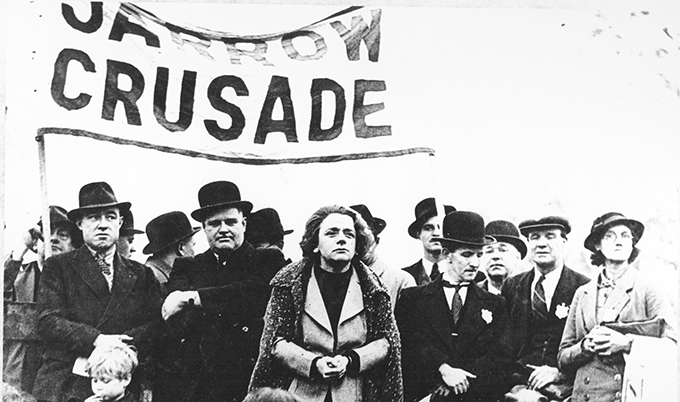Comment: Jarrow crusade: 80 years on the marchers’
Comment: Jarrow crusade: 80 years on their message still resonates
Published on: 6 October 2016
Writing for The Conversation, Dr Matt Perry explains why the Jarrow Crusade is still relevant today

On October 5 1936, 200 unemployed men from Jarrow in north-east England set out for London carrying a petition asking for work to be brought to their town. Their march, which took just under a month, has become a historic landmark symbolising the depression of the 1930s, the human suffering it induced and the north-south divide.
Medical students volunteered to tend to the marchers’ blistered feet and fragile bodies, which had been enfeebled by a diet on the borderline of malnutrition. Eating good food on the march, paid for with funds collected from well-wishers, one participant called James Walters gained eight pounds on the way to London. The crusade also exposed the longer-term signs of impoverished diets: William Cameron had all this teeth removed during the march, others were hospitalised or sent home, and heavily indebted 45-year-old Thomas Dobson had heart failure, dying eight weeks after the crusade’s return to Jarrow.
The route graphically illustrated England’s inequalities. Jarrow had the dubious honour of being the nation’s capital of infant mortality at the time. You were twice as likely to see your child die before the age of one in the town than in the country as a whole, and three times as likely as in Market Harborough, the Leicestershire town that the march passed through after 18 days on the road.
When the marchers arrived in Hyde Park, London on October 31, much of the capital was thriving with new industries and booming construction. The contrasts are powerfully illustrated in Thomas Dugdale’s 1936 painting The Arrival of the Jarrow Marchers.
Rebuffed disappointedly by the government, the march did not bring work to Jarrow. It was World War II that revived employment in the town and the post-war settlement that ended overcrowding. However, from the mid-1970s, Jarrow once again became a site of high unemployment and from that time the forgotten march began to re-emerge from the historical oblivion into which it had slipped.
Dead towns
There are a dwindling number of people left alive who can remind us of the stigma of the means test that was required to qualify for unemployment benefit or what health provision was like before the NHS. The decade of the 1930s widened inequalities just as the current age of austerity has done today.
That’s why the ghosts of the crusade still hang over today’s austerity Britain. Since the 2008 financial crash, workplaces have closed and household names such as Woolworths and British Home Stores have gone into administration. The threats to steel manufacturing in Redcar, also in north-East England, and Port Talbot in Wales, are eerily reminiscent of the 1939 warning by Labour MP Ellen Wilkinson in The Town That was Murdered, a book about Jarrow, that the capitalist system could cut the “life-line” of a town. Recession has strewn the world with murdered towns and cities – ports transformed by containerisation, closed steel works, as well as mining centres and factory towns that have lost their principal reason for existence. In the 1930s, there were an estimated 50m unemployed globally, today it’s more than 200m.
When viewing the images of the Jarrow crusade today, there is a danger of falling into a nostalgic trap of discriminating between the deserving poor of the past and the undeserving poor of the present. In this view, the honest men of the crusade with their heads held high were not like undeserving single mums, scroungers and chavs on the “benefits street” today.
But we forget that the unemployed of the 1930s also faced a press that depicted them as dole cheats and dole brides (who married while on benefits), and a burden on public finance. The great triumph of the Jarrow crusade was that it humanised the victims of austerity. The marchers’ public meetings held in the evenings after their day’s marching relayed the experiences of the depression and of long-term unemployment.
Fight against anonymity
Time has anonymised the marchers as it anonymises the current victims of neo-liberal austerity. For this reason, the commemorations of the march in 2016 have asked “who were the marchers?” Each marcher has a name, a life story beyond the march and descendants who face the uncertainties of the future. All the marchers deserve to be recovered from this anonymity in order to discover their overcrowded living conditions, the waste of their talents, the ill health and hardships that they and their families endured.
During the project to commemorate the 80th anniversary, children at Jarrow’s schools have discovered crusader forebears. Great grandsons and daughters discovered about Philip McGhee, a crane operator and keen footballer at St Bede’s Football Club, Robert Maughan and John Mogie of the mouth organ band, Joe Symonds, later a Labour MP for Whitehaven, Jimmy Hobbs who was 20 at the time of the march and went on to join the navy during World War II.
To put a human face to the suffering inflicted during global crises helps us to pose great questions about our age: unemployment, inequality, homelessness and de-industrialisation.
To challenge the Jarrow marchers’ anonymity is to challenge the fatalism of the age. The crusaders therefore provide a potent lesson for trade unions and social movements today: their battle against injustice and inequality can be an inspiration for those today who merely despair at their plight without trying to change it. Though the government denied their immediate demands, the Jarrow marchers contributed to a sea change in the political consensus that brought the post-war welfare state to the UK.
Matt Perry, Reader in Labour History, Newcastle University
This article was originally published on The Conversation. Read the original article.



